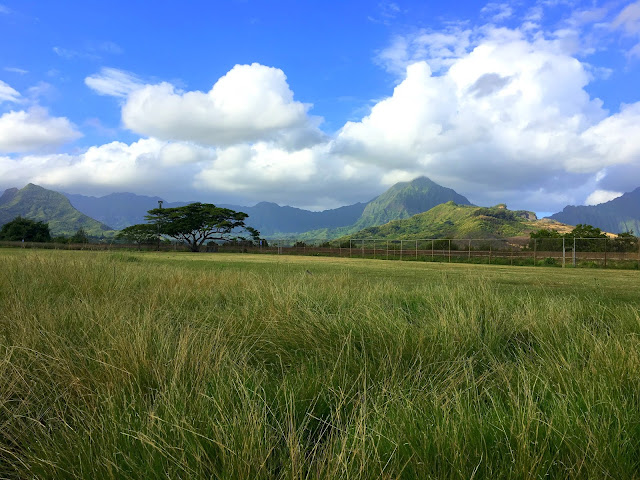Kawainui Marsh in Kailua is largest
extant wetland in state of Hawaii and encompasses about 800 acres of beautiful
wetlands. “Kawai” means water and “Nui” means large or abundant and refers
to what really is a flood control levee at the foot of the ever-majestic Ko’olau
Mountain Range.
This marshland has a geological past
dating back to 4000 years ago, significant natural history and cultural history
dating back to nearly 1000 years ago. It
is situated in center of former Ko‘olau volcano, Kawainui was an inland extension of waters of Kailua
Bay.
Overtime it was replaced by sandbar
and eventually with the arrival of Hawaiian settlers it was used as fish pond. They also planted lo‘i kalo (taro fields)along the streams and around the edges of
the pond. Eventually as western civilization invaded Hawaiian land, the taro
fields were replaced by rice fields and cattle ranch. Today, Kawainui is a wahi pana (storied place of cultural
importance) and a wildlife sanctuary for migratory and waterbirds.
Today, water flows in the marsh from streams
from Maunawili and Kapa‘a Valleys, springs along the Kūkanono slope, rainfall,
and run-off and the levee helps to
contain the water, preventing its
run-off. In fact, it’s earlier name was Kawai
Nui Loko, or "the big freshwater pond."
Kawainui-Hāmākua is also home to
Hawai‘i’s 4 endangered waterbirds:
the Hawaiian stilt (aeʻo), the Hawaiian coot (ʻalae keʻokeʻo), the
Hawaiian gallinule (ʻalaeʻula) and the Hawaiian duck (kōloa maoli).
It is also home to several native
marsh plants, including the neke fern and ‘uki (sawgrass). Restoration seeks to
remove invasive plants, open water areas, and improve habitat for the native
flora and fauna.
Culturally it is site of terraced rock
walls of former housesites and lo‘i kalo,
grinding stones for finishing stone adzes, and 3 large heiau or Hawaiian temples(Ulupō,
Pahukini, and Holomakani).
Hamakua Marsh is a smaller wetland
historically connected to and immediately downstream of Kawainui Marsh, which
also provides significant habitat for several of Hawaii's endemic and
endangered waterbirds.
Today, the Kawai Nui Marsh Trail is 3 miles round trip scenic, paved
trail in heart of Kailua, away from hustle and bustle of the town. It is not
much of a hike, but an experience unlike any other nature walk. You experience
the beauty of wetland, amid the backdrop of majestic and magnificent Ko’olau mountains,
hearing the chirping and quacking of birds and water birds and soaking in the
greenery of flora.
 |
| parking lot |
Being
paved and graveled, it is suitable for strollers and wheelchairs as well as
hiking with small children. Many people come here for walking the dog too. Parking is free and easily available.
There is a picnic table and open lawn
at the start of the trail if you want to have a picnic lunch.
 |
| picnic table |
 |
| The beginning of Kawai Nui Marsh Trail |
 |
| The levee on the trail |
 |
| Majestic Ko'olau Mountains in the backdrop |
 |
| wild flowers |
 |
| wild flowers |
 |
| Water Hyacinth |
 |
| The marsh |
 |
| Algae in the Marsh |
 |
| A panoramic view of the trail |
 |
| The other side of levee |
 |
| A bicycle rider |
 |
| Nature's cut work |
 |
| Nature's cut work |
 |
| Houses on other side of levee |
 |
| Nature's cut work |
 |
| Bicycle stand |
Over the years, Kailua community and
other communities have invested thousands of man hours to restore the native
wetlands. Ho‘olaulima Iā Kawainui is a
network of conservation, native Hawaiian, educational, and community
organizations who came together in 2004 to assist with planning the future of
the Kawainui-Hāmākua Marsh Complex. The organizations comprising Ho‘olaulima are
working with the State and the community on the restoration, interpretation,
and stewardship of the marsh complex and the many significant natural and
cultural resources that comprise this complex. A list of member organizations
of . Ho‘olaulima Iā Kawainui and other
information can be found on the flyer.
Ho‘olaulima Iā Kawainui has worked
upon developing interpretive
opportunities of Kawainui and Hāmākua. This will help in connecting people by
sharing messages and themes and creating awareness about the geological and
cultural importance of marshlands. It will also help into preservation and
protection of the marsh and its resources for future generations.
The interpretive opportunities are
also looking to build a visitor center, lookout and viewing platforms along the
trails and providing hands-on opportunities for kiekies to learn how the marsh
and wetlands were created.
The work at Kawainui
is never-ending. Kailua Neighborhood Board president Charles Prentiss wrote, “Wetlands
worldwide are being lost to encroachment and development of this kind, and the
best of intentions to build “green or sustainably” can only manage the degree
of harm, not prevent it.”









































Wow, beautiful place.....
ReplyDeleteBeautiful , wish we had gone when we were there. Really liked Nature Cutwork on the leaves. The skies and the wild flowers and the algae ... all look amazing. Great information . Thank you
ReplyDelete